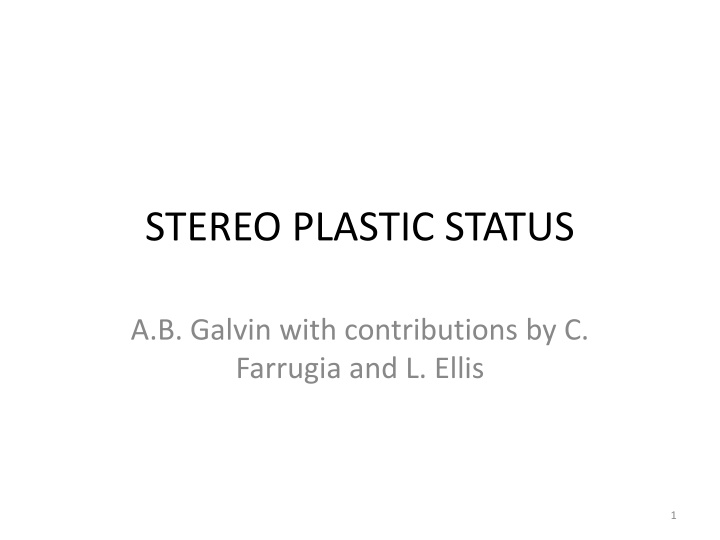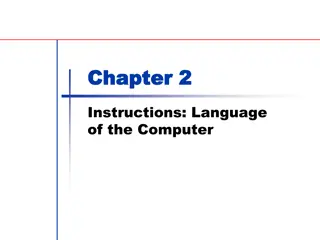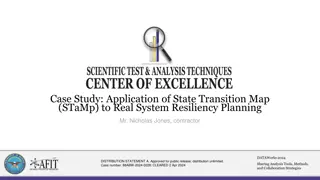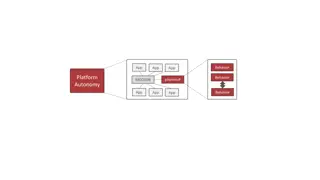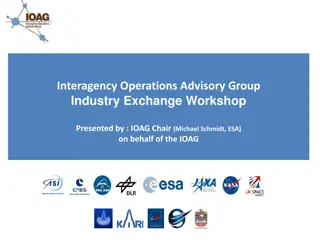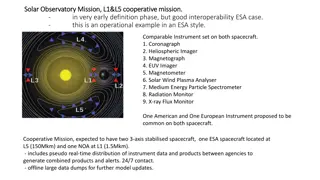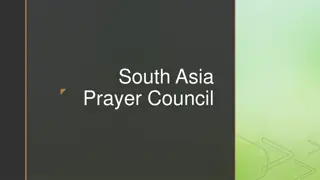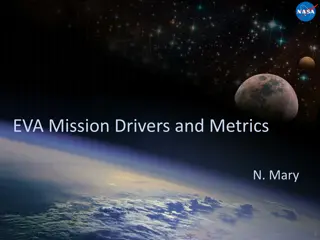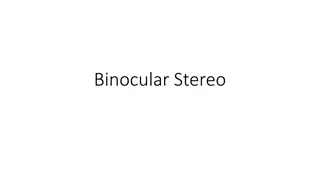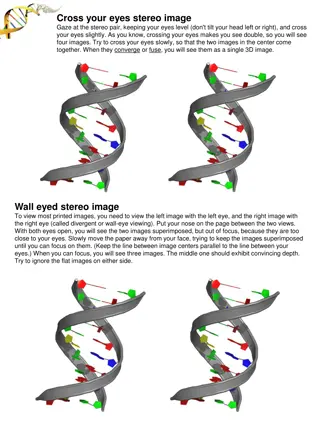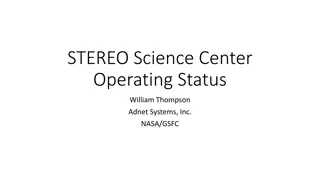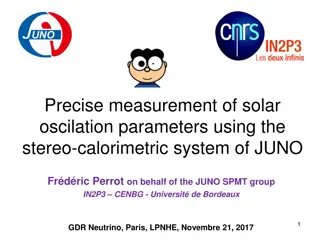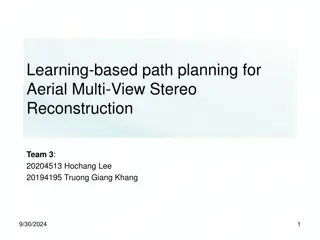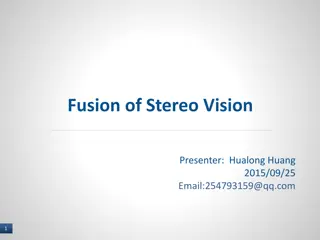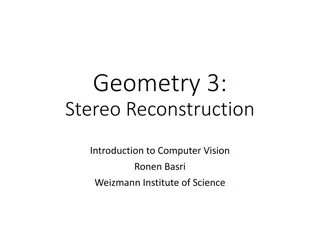Operations Update and Planning for STEREO Mission
Operations for the STEREO mission are adjusting telemetry to meet reduced rates, affecting data processing and efficiency of systems. Planning is underway for changes post-mission flip, with concerns on extended non-operations. Data products being updated, while science observations focus on coronal mass ejections from the Sun to 1 AU.
Uploaded on Sep 06, 2024 | 2 Views
Download Presentation

Please find below an Image/Link to download the presentation.
The content on the website is provided AS IS for your information and personal use only. It may not be sold, licensed, or shared on other websites without obtaining consent from the author.If you encounter any issues during the download, it is possible that the publisher has removed the file from their server.
You are allowed to download the files provided on this website for personal or commercial use, subject to the condition that they are used lawfully. All files are the property of their respective owners.
The content on the website is provided AS IS for your information and personal use only. It may not be sold, licensed, or shared on other websites without obtaining consent from the author.
E N D
Presentation Transcript
STEREO PLASTIC STATUS A.B. Galvin with contributions by C. Farrugia and L. Ellis 1
Operations In order to meet reduced telemetry we have been eliminating some ApIDs (31A, 31B, 31E, 31F, 320) and in other cases (31C, 31D) have extended accumulation times up to 2 hours. Some routine processing programs are currently under revision to accommodate variable accumulation times. This will allow us to extend accumulation times for priority rates, if it becomes necessary to reduce telemetry further. 4
Operations Operation is nominal, except for The reduced telemetry, creates data gaps and some APIDs have been commanded either off or with increased time accumulation Apparently the new telemetry reduction requires a new turn on procedures after an IDPU reboot (aka MAG anomaly recovery operations) Reduced efficiency on MCPs, particularly for STB Issue stems from the entrance system design, which did not meet specifications Primarily affects minor species, not the protons Looking at what over head is left in operational voltages Problem should be alleviated once s/c flips (new section of MCPs exposed) 5
After the Flip Have started team planning for changes to processing programs to accommodate new orientation (L. Ellis) Instrument efficiencies will be different as different parts of the detectors will be exposed (K. Simunac and A. Galvin) Have started planning recommissioning activities (J. Gaidos and M. Popecki) Have some concern about how cold the power supplies will become under extended non-operations. John Gaidos has been returned to STEREO activities with these operational plans (was the system engineer on PLASTIC). 6
Level 2 data products STEREO B updated through Dec 31, 2013 STEREO A updated through Nov 30, 2013 Level 3 data products STEREO A He+ pickup ions through 2012 2013 in process 7
Connecting white light to in situ observations of 22 coronal mass ejections from Sun to 1 AU Moestl, C., K. Amla, J. R. Hall, P. C. Liewer, E. M De Jong, R. C. Colannino, A. M. Veronig, T. Rollett,. M. Temmer, V. Peinhart, J. A. Davies, N. Lugaz, Y. Liu, C. J. Farrugia, J. G. Luhmann, B. Vrsank, R. A. Harrison, and A. B. Galvin, Connecting speeds, directions and arrival times of 22 coronal mass ejections from the Sun to 1 AU, Astrophys. J., under review 2014. CME parameters were predicted mainly from STEREO/HI with 3 different models. With STEREO we connected CME observations from coronagraph to HI to in situ data at 1 AU. Three different model geometries of the ICME shape were used for propagating the disturbance in interplanetary space. The results were checked against in situ observations made by STEREO B and Wind. Relationships were found which make it possible to optimize these predictions. The result is that with the new relationships, in situ speeds can be predicted within 100 km/s for 88 % of all events. For the arrival times, prediction works within +/8 hours (71% of all events). While these inferences are valid for this particular set of 22 CME events, we note that the data set includes a quite full spectrum of CME speeds (range: 300-2700 km/s). 9
Complex evolution of coronal mass ejections in the inner heliosphere: a review As they propagate, CMEs interact with the solar wind and preceding eruptions, which modify their properties. Lugaz, N., C. J. Farrugia, and N. AlHaddad, Proc. IAU Symposium No. 300, Nature of Prominences and their role in space weather, eds. B. Schmieder, J.M. Malherbe, S.Wu, 2014. In the past ten years, the evolution of CMEs in the inner heliosphere has been investigated with the help of numerical simulations, through the analysis of remote sensing observations, especially with the SECCHI suite onboard STEREO, and through the analysis of multispacecraft in situ measurements. Most studies have focused on understanding the characteristics of the magnetic flux rope thought to form the core of most CME. Regarding modeling: We have magnetic flux ropes as a sufficient model to understand CMEs, but is it also necessary? More importantly, most flux rope models used to analyze observations appear overly simplistic as compared to observations, which often reveal bends and writhe as well as a varying cross section shape along the CME axis . 11
Combination of successive coronal mass ejections causing an extreme storm in interplanetary space Y. D. Liu , J. G. Luhmann, P. Kajdic, E. K. J. Kilpua, N. Lugaz, N. V. Nitta, C. Moestl,, B. Lavraud, S. D. Bale , C. J. Farrugia, A. B. Galvin, Nature Communications 12
Extreme Event Using multipoint remote sensing and in situ observations, we report an extreme event occurring on the farside of the Sun and observed by STEREOA on 2012 July 23. Maximum speed near the Sun: 3050 km/s. At STEREOA, a peak solar wind speed of 2246 km/s was observed followed by a magnetic cloud whose peak magnetic field strength reached 109 nT. Such conditions would have produced a record genoagnetic storm if the eruption were Earthdiredted. Novel features: (1) The interaction of two closely launched coronal mass ejections resulted in the extreme enhancement of the magnetic field strength and (2) A preconditioning of the upstream solar wind by an earlier solar eruption led to the unusually weak deceleration of the event. This event gives us clues as to how severe geomagnetic storms may be generated through CME interactions near the Sun in special conditions. 13
PLASTIC Bibliography -1 Al-Haddad, N., T. Nieves-Chinchilla, N. P. Savani, C. Moestl, K. Marubashi, M. Hidalgo, I. I. Roussev, S. Poedts, C. J. Farrugia, Magnetic field configuration models and reconstruction methods for interplanetary coronal mass ejections, Solar Phys, 284:129-149, DOI 10.1007/s11207-013-0244-5, 2013. Baker, D.N., X. Li, A. Pulkkin, C.M. Ngwira, M.L.. Mays, A.B. Galvin, K.D.C. Simunac, A major solar eruptive event in July 2012: Defining extreme space weather scenarios, Space Weather, 11, pp 585-591, doi: 10.1002/swe.20097, 2013. Barry, J.A., A. B. Galvin, M. Popecki, B. Klecker, H. Kucharek, K. Simunac, C. J. Farrugia, J. G. Luhmann, L. K. Jian, Analysis of Suprathermal Proton Events Observed by STEREO/PLASTIC Focusing on the Observation of Bow Shock/Magnetospheric Events, Solar Wind 13, AIP Conf. Proc. 1539, 382-385, doi:10.1063/1.4811065, 2013. Drews, Christian, Lars Berger, Robert F. Wimmer-Schweingruber, and Antoinette B. Galvin, Interstellar He+ Ring-Beam Distributions: Observations and Implications, Geophysical Research Letters, doi: 10.1002/grl.5036, 2013. Enr Quez-Rivera, O., Blanco-Cano, X., Russell, C. T., Jian, L. K., Luhmann, J. G., Simunac, K. D. C., Galvin, A. B., Mirror-mode storms inside stream interaction regions and in the ambient solar wind: A kinetic study, Journal of Geophysical Research: Space Physics, Volume 118, Issue 1, pp. 17-28, 2013. Jian, L.K., C.T. Russell, J.G. Luhmann, A.B. Galvin, and K.D.C. Simunac, Solar wind observations at STEREO: 2007-2011, Solar Wind 13, AIP Conf. Proc. 1539, 191-194, doi:10.1063/1.4811020, 2013. 14
PLASTIC Bibliography -2 Klecker, B., Current understanding of SEP acceleration and propagation, in J. Phys., Conf. Ser. 409, 012015 doi:10.1088/1742-6596/409/1/012015 (2013). Galvin, A.B., K.D.C. Simunac, L.K. Jian, C.J. Farrugia, and M.A. Popecki, Solar wind ion observations: Comparison from the depths of solar minimum to the rising of the cycle, Solar Wind 13, AIP Conf. Proc. 1539, 15-19, doi:10.1063/1.4810978, 2013. Liu, Y.D., J. G. Luhmann, P. Kajdic, E. K. J. Kilpua, N. Lugaz, N. A. Nitta. C. Moestl, B. Lavraud, S. D. Bale, C. J. Farrugia, and A. B. Galvin, Observations of an Extreme Storm in Interplanetary Space Caused by Successive Coronal Mass Ejections, Nature Communications, 2014. Luhmann, J.G., M. Ellenburg, P. Riley, D. Odstrcil, G. Petrie, E. Kilpua, L.K. Jian, C.T. Russell, K. Simunac, and A.B. Galvin, Large Scale solar wind structure: Non-dipolar features and consequences, Solar Wind 13, AIP Conf. Proc. 1539, 110-115, doi:10.1063/1.4811001, 2013. Lugaz, N., C. J. Farrugia, and N. Al-Haddad, Complex evolution of coronal mass ejections in the inner heliosphere, as revealed by numerical simulations and STEREO observations: A review, Nature of Prominences and their role in Space Weather, Proceedings IAU Symposium, eds. B Schmieder, J. -M. Malherbe, No. 300, 2014. Moestl, C., K. Amla, J. R. Hall, P. C. Liewer, E. M De Jong, R. C. Colannino, A. M. Veronig, T. Rollett,. M. Temmer, V. Peinhart, J. A. Davies, N. Lugaz, Y. Liu, C. J. Farrugia, J. G. Luhmann, B. Vrsank, R. A. Harrison, and A. B. Galvin, Connecting speeds, directions, and arrival times of 22 coronal mass ejections from the Sun to 1 AU, Astrophys. J., 2014. 15
PLASTIC Bibliography -3 Ngwira, C. M., A. Pulkkinen, M. Leila Mays, M. M. Kuznetsova, A. B. Galvin, K. Simunac, D. N. Baker, X. Li, Y. Zheng, and A. Glocer (2013), Simulation of the 23 July 2012 extreme space weather event: What if this extremely rare CME was Earth directed?, Space Weather, 11, 671 679, doi:10.1002/2013SW000990, 2013. Popecki, M.A., B. Klecker, K.D.C. Simunac, A.B. Galvin, and H. Kucharek, On the variability of He+ Suprathermal Tails, Solar Wind 13, AIP Conf. Proc. 1539, 255-258, doi:10.1063/1.4811036, 2013. Russell, C.T., R.A. Mewaldt, J.G. Luhmann, G.M. Mason, T.T. von Rosenvinge, C.M.S. Cohen, R. A. Leske, R. Gomez-Herrerro, A. Klassen, A.B. Galvin, K.D.C. Simunac, The Very Unusual Interplanetary Coronal Mass Ejection of 2012 July 23: A Blast Wave Mediated by Solar Energetic Particles, The Astrophysical Journal, doi:10.1088/0004-637X/770/1/38, 2013. Simunac, K.D.C., A.B. Galvin, C.J. Farrugia, Y.C.-M. Liu, and J.G. Luhmann, Multi-spacecraft observations of the heliospheric plasma sheet, Solar Wind 13, AIP Conf. Proc. 1539, 66-69, doi:10.1063/1.4810991, 2013. Webb, D.F., C. Moestl, B.V. Jackson, M.M. Bisi, T.A. Howard, T. Mulligan, E.A. Jensen, L.K. Jian, J.A. Davies, C.A. de Koning, Y. Liu, M. Temmer, J.M. Clover, C.J. Farrugia, R.A. Harrison, N. Nitta, D. Odstrcil, S.J. Tappin, H.-S. Yu,,Heliospheric Imaging of 3D Density Structures During the Multiple Coronal Mass Ejections of Late July to Early August 2010, Solar Phys, 285, 317-348, doi: 10.1007/s11207-013-0260-5, 2013. Yu, W., C.J. Farrugia, A.B. Galvin, K.D.C. Simunac, E.K.J. Kilpua, M.A. Popecki, C. Moestl, N. Lugaz, J.G. Luhmann, A. Opitz, and J.-A. Sauvaud, Small solar wind transients: Stereo-A observations in 2009, Solar Wind 13, AIP Conf. Proc. 1539, 311-314, doi:10.1063/1.4811050, 2013. Yu, W., C. J. Farrugia, A. B. Galvin, C. Moestl, K. D. C. Simunac, and R. B. Torbert, A statistical analysis of Properties of Small Transients in the solar wind, 2007-2009: STEREO and WIND Observations, J. Geophys. Res. Space Physics, 119, doi:10.1002/2013JA019115, 2014. 16
